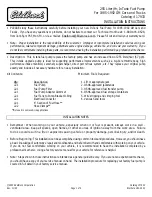
Chapter 3 Engine Fuel Injection System
Section I Brief Introduction of Development of Engine Fuel
Injection and Electronic Control System
Question appeared
With the quick development of the automobile industry, the crisis of energy sources and exhaust pollution
become serious day by day. Now the countries all over the world pay much attention to this, especially in the
United States where the autos is widely used, the United States parliament has passed a decision of ‘Zero
Pollution of Automobile Exhaust’ though they knew it is very difficult and even impossible, and if they don’t do
so, the human cannot survive on the earth as the quantity of the autos is greatly increasing which enable the great
transformation on the structure of the autos on the existing basis and to manufacture the ‘green’ autos without
pollution, and so the fuel injection electronic control autos , the solar energy autos and electric autos appear.
Shortcomings of Carburetor Engine
(1) The adjustment of the mixture concentration is not precise, and it lags in the demand of the engine. The
adjustment of thickness inside the carburetor is that when the working condition changes, adjust it by manually
control mechanical type which cause the precision being limited and lagged in the actual demand.
(2) The quality of the mixture is not good, especially when the rotating speed varies or is at low speed, the
mixture is in disproportion which causes the inadequacy combustion.
(3) The pollution of the exhaust is badly serious. The exhaust pollution is badly serious under the condition
that the idle speed and the working condition changes, this is the deadly shortcoming of carburetor and also the
important reason that it is limited to use.
(4) The vibration is intense and it is easy to be flameout.
(5) The working condition is affected by the posture of engine.
Advantages of Fuel Injection Electronic Control
(1) The metering is precise, spot-injection uniformly, keep the air-fuel ratio in a good state.
(2) Three “NO” bring three ”GOOD”: No throat resistance and intake preheating influence, but charging
efficiency is good; No flow loss and influence of reverse and air change, but burning condition is good; No
influence of poor atomization and misdistribution , but the thermal efficiency is good.
(3) Get a good power performance, economic performance and decontamination effect. The power can
improve by 15%~20%, fuel consumption can reduce by 1% to 5%, exhaust pollution decrease obviously, CO<1
%,
HC<100×10
-6
”, peak torque improve by 5%~7%, accelerating time can decrease by 20%.
(4) Improve the operational performance: it will improve the cold starting performance, heating start
performance, transition performance, the anxious acceleration anti-pollution performance, the load
self-modulation performance and prevent the extinguishment characteristics and so on.
(5) Expand the control function, increase the diagnosis function. Because the computer (ECU) is used to
control, can cover the ignition, the fuel injection, the automatic transmission, ABS braking system, the cruise
system, the air-conditioning system, the automobile body highly self-modulation system, the suspension fork
rigidity non-linear self-modulation system, the security alarm system and so on, because having the storage and
memory ability, it has self-examined function and the fault assurance function..
(6) Reduce the failure rate of pipeline and circuit. As the important component is the computer, the failure
rate of 100000km is only 1/1000; and also more control parts, little move parts, so the wearing parts is little and
failure ratio decreases obviously.
Brief History for Development of Fuel Injection Electronic Control
The gasoline jet type engine appeared in 1930, and was installed on the military airplane engine. At that time
the main purpose was to prevent the carburetor from icing up while in the upper air or in cold season, and it was
easy to affect the normal working of the carburetor when flying position changes.
















































